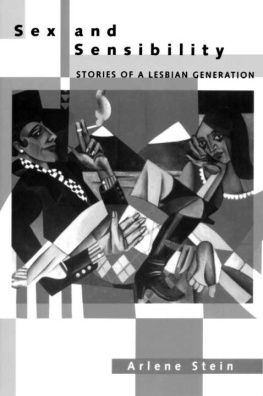The
Disappearing
L
SUNY series in Queer Politics and Cultures
Cynthia Burack and Jyl J. Josephson, editors
The
Disappearing
L
Erasure of Lesbian Spaces and Culture
Bonnie J. Morris
Published by State University of New York Press, Albany
2016 State University of New York
All rights reserved
Printed in the United States of America
No part of this book may be used or reproduced in any manner whatsoever without written permission. No part of this book may be stored in a retrieval system or transmitted in any form or by any means including electronic, electrostatic, magnetic tape, mechanical, photocopying, recording, or otherwise without the prior permission in writing of the publisher.
For information, contact State University of New York Press, Albany, NY
www.sunypress.edu
Production, Emily Keneston
Marketing, Kate R. Seburyamo
Library of Congress Cataloging-in-Publication Data
Names: Morris, Bonnie J., 1961 author.
Title: The disappearing L : erasure of lesbian spaces and culture / Bonnie J. Morris.
Description: Albany : State University of New York Press, 2016. | Series: SUNY series in queer politics and cultures | Includes bibliographical references and index.
Identifiers: LCCN 2015042618 (print) | LCCN 2016011561 (ebook) | ISBN 9781438461779 (hardcover : alk. paper) | ISBN 9781438461786 (e-book)
Subjects: LCSH: Lesbian cultureUnited StatesHistory. | FeminismUnited StatesHistory. | Women's studiesUnited States.
Classification: LCC HQ76.96 .M67 2016 (print) | LCC HQ76.96 (ebook) | DDC 306.76/630973dc23
LC record available at http://lccn.loc.gov/2015042618
10 9 8 7 6 5 4 3 2 1
for Shannon Marie
and in gratitude to the vanished:
Mary Daly
Therese Edell
Maxine Feldman
Louise Fitzhugh
Kay Gardner
Barbara Grier
Audre Lorde
Julia Penelope
Adrienne Rich
You may forget but
Let me tell you
This: someone in
Some future time
Will think of us
Sappho
We came up in the 1950s at zero. And look what we have now: the freedom to be in your face! Just keep hope. Just keep going; dont let it get to you. When we first wrote Lesbian/Woman , an editor rejected it by telling us, You act as though your lifestyle is good, and thats impossible.
Del Martin
Every wise woman buildeth her house;
But the foolish plucketh it down with her hands.
Proverbs 14:1
I dont explain and defend well at the same time. Theyre two different activities.
Jane Rule
Contents
Introduction
The Treasure Hunt
If you destroy an entire generation of a peoples culture, its as if they never existed.
Film trailer for The Monuments Men
Now, in case youre thinking this kind of thing only happens to butch womenI say, look again. I submit that every one of you is an insert in the textbook of your country. I look out over this sea of nonessential faces, and I can see the little borders around your lives, individually and collectively. You are inserts in the lives of men. You are inserts in the history of your nation. And when it comes down to the real issues, we will all be missing from the program.
Carolyn Gage, The Second Coming of Joan of Arc
I write as woman, lesbian and feminist, she told the Washington Post in 1981. I make no claim to be universal, neuter or androgynous.
Obituary for Adrienne Rich, Washington Post, March 28, 2012
I, too, write as woman, lesbian, and feminist; a dinosaur facing extinction in this new queer jungle. Im writing now to describe what it looks and feels like to be written out of history.
My generation of lesbian activists, who honed our identity politics and confronted racism and classism in the spaces of womens music events and womens bookstores, are approaching a cultural expiration The recent, ongoing interrogation of those categories in academic theory and cyberactivism clashes with concurrent efforts to preserve, as historically meaningful and valuable, the past forty years of lesbian cultural spaces. Yet making peace with the radical separatist past is an important historical step for those charting the progression of LGBT visibility, rights, and power. The present impasse, in the LGBT movement, is over how to frame lesbians successful construction of an autonomous subculture that was not G, that was not T, but L.
My concern is that as we advance farther into the twenty-first century, we are witnessing the almost flippant dismissal of recent, latetwentieth-century lesbian culture, particularly the loss of physical sites such as womens bookstores and womens music festivals and their material legacies (books, journals, albums, tapes, magazine interviews with artists.) This was a specific performance culture: a movement through which fresh ideas about woman-loving were transmitted via song, speech, and the written word, and marketed to a like-minded audience at quasi-public but distinctively lesbian feminist spaces. At its peak, lesbian performance culture in the 1970s, 80s, and 90s was every bit as unique as gay male drag, punk rock, Seattle grunge, and other genres, particularly because it put a new face on the tradition of grassroots American folk. However, because most womens music recording artists earned very little money, and not only neglected but rejected commercial male approval and participation, their contributions are difficult to place on the Rock and Roll Hall of Fame timeline.
While lesbian spaces and events are quietly vanishing due to a trifecta of political, financial, and technological pressures, feminist scholars who historicize the meaning of lesbian eras are increasingly ambivalent about whether women-only spaces were ever appropriate or progressive. Many of our best radical theorists have shifted their professional focus from womens history to queer studies, and the result is both disappearance and a devaluing of things uniquely lesbian. If anything, a retroactive stigma now applies to lesbian events that excluded men or men transitioning to embodied femininity.
Despite so many gains in LGBT rights, sexism and sex discrimination have not been vanquished, and scholarly support for examining womens lives and communities remains contested. The traditional academic canon, with its focus on male achievement and leadership, embeds many contributions by gay men through the ages, whereas lesbians have had barely a generation and a half of scholarly scrutiny (corresponding to how recently women were allowed to attend college at all.) Although womens studies programs have always been charged with pushing a lesbian agenda, or just being controlled by man-hating lesbians, this was never true and is even less true now. In fact, as womens studies programs expand to attract male and trans-identifying faculty and students, many administrators are backing away from the word women altogether, striving for inclusion by renaming departments Gender Studies. Students in 2016 are indeed more likely to study transgender rights than lesbian rights, especially as older lesbian institutions are scrutinized for their inclusion of transwomen. Womens studies departments may have been slapped with the L-word label in the past; today, students and faculty looking at recent lesbian history must dodge a new slur, TERF (Trans-Excluding Radical Feminist).
Although various woman-identified, lesbian separatist platforms and events that characterized a self-proclaimed dyke subculture throughout the 1970s1990s still exist, they arent yet popular subjects of historical inquiry. Instead, these remaining activists and institutions have become popular subjects of criticism and contempt. Despite a wealth of feminist scholarship on aging, elder abuse, and the intersectionality of ageism and sexism in older womens economic vulnerability, far less work has been produced on the aging lesbian, who (whether activist veteran or not) offers a wealth of generational tales and insights. In the United States, OLOC (Old Lesbians Organizing for Change) is enhancing the collection of narratives and staging multi-city conferences to preserve lesbian oral histories; yet in the United Kingdom, the work of scholar Jane Traeis (who collected life narratives from lesbian elders) has revealed the anxiety many aging lesbians feel about sharing truthful memories with possibly homophobic caregivers.



![Chuck Stewart - Lesbian, Gay, Bisexual, and Transgender Americans at Risk [3 Volumes]: Problems and Solutions](/uploads/posts/book/129596/thumbs/chuck-stewart-lesbian-gay-bisexual-and.jpg)

